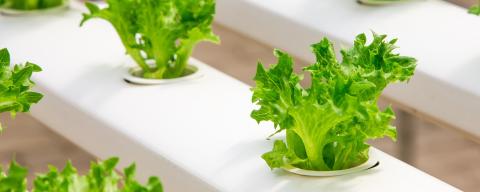By Jonathan Ebba, UNH Extension Field Specialist, Landscape & Greenhouse
Published August 2023
Introduction
Hydroponics is the production of plants using water instead of soil to deliver the nutrients essential to plant growth. As hydroponics becomes more common as a commercial food production method in the Northeast, people are expressing interest in trying these methods on a small scale in their homes or backyards. Several advantages exist to hydroponics production:
- Water use can be 80% to 95% lower than for irrigated field-grown crops.
- Fertilizer run-off is almost non-existent.
- Pesticide use can be dramatically lower than in field-grown crops and is often unneeded.
- Crops mature faster.
- Indoor systems can allow for year-round production.
- Hydroponics does not require prime soils, allowing production on otherwise non- farmable land.
Did you know? - Hydroponics at home can provide year-round produce, prevent nutrient run-off to the environment and use 90% less water.
Home hydroponics can utilize a ready-made unit or can be designed and constructed using general supplies available from a local hardware store and/ or specialized supplies from a hydroponics supplier. Part of the fun and appeal of home hydroponics is the ability to tailor a system to suit the needs/ space/ desired effort of the owner.
The driving principle for hydroponics is that the nutrients needed by a plant are supplied by being dissolved in water rather than as present in the soil. As such, there is a lot of variation in what a hydroponics system can look like. From systems which recirculate water and nutrients in specialized troughs, to simple 5 gallon buckets filled with potting media and hand watered with fertilizer, hydroponic systems can vary greatly to suit your needs and desires.
This fact sheet is intended to help non-commercial hydroponics growers start growing in their homes. For commercial producers who need to operate at a level of production for commercial viability, some of the following suggestions will be inadequate; contact your local Cooperative Extension for assistance.
Primary Needs
If soil is not required to grow a plant, what does a plant require? The following five factors are critical for plant growth; any successful hydroponics system must provide all of these: water, nutrients, light, carbon dioxide and oxygen.
Water:
Whatever type of system is used, water levels must be maintained and roots must not dry out. As plants take up water and release it through their leaves (transpiration), the water level in the system will drop and must be replenished. You will need to monitor the water level in your system regularly. When designing your system, think about whether roots might dry out with rising or falling water levels.
Although water in the system is absolutely critical, some people put more importance on water quality than is necessary. Use water that’s safe to drink for your hydroponics system. Water from a well or from a municipal supply is fine. A lot is made of water pH in hydroponics, and for commercial producers, correct pH is important to maximize uptake of micronutrients, but fine-tuning water pH can be difficult and expensive. For home hydroponics a water pH between 5.5 and 7.0 is fine.
As far as other elements dissolved in the water (minerals, “hardness”, chloride, etc.), a commercial producer will mix up exactly the nutrients needed for the crop so knowing the level of these nutrients already in the water will allow her to save money by including less of these. You are likely to use a pre-formulated fertilizer, however, so knowing the concentration of plant nutrients already in your water will be of little value.
Nutrients:
Plants need 13 different nutrients to grow properly. These are elements like nitrogen, phosphorus, potassium, calcium, etc. In a healthy garden these elements are being held and released by soil particles. In a hydroponics system, these are provided by dissolving fertilizer(s) in the water. “Nutrient solution” refers to the mixture of water and fertilizer in a hydroponics system. Calculating, mixing and maintaining the nutrient solution might be the trickiest part of planning and operating a hydroponics system.
Did you know? - In hydroponics, fertilizers, not soil, supply the nutrients needed for plant growth.
Home hydroponics growers now have more fertilizer options than ever. Fertilizers formulated for hydroponics can be purchased from many local hardware stores as well as from online stores. For leafy greens, select a fertilizer formulated for vegetable production or one formulated for “growth” (instead of “bud” or “bloom”). Dry fertilizers have a much higher concentration of nutrients than liquid concentrates, so dry fertilizers may cost more per container, but typically make much more nutrient solution and will cost less in the long run. Some people prefer the ease of use of a liquid, and for people just starting up with a small system, the lower initial price of a liquid may be most appropriate.
The simplest approach is to purchase a “one-bag” or “one-bottle” complete fertilizer. These tend to be low in calcium and magnesium and are more expensive in the long run than other options, but their ease of use and the simplicity of a single product make them appealing for home hydro, particularly when beginning. What is called a “two bag” or “two bottle” solution may be a more efficient use of nutrients and money. Calcium doesn’t dissolve well with some other elements and can fall out of solution as solid chunks when all of these nutrients are mixed together at high concentrations. A solution to this problem is to mix one tank containing calcium nitrate and a second tank containing everything else. Two-bag and two-bottle solutions (often called “Part A” and “Part B”) are available for this purpose. A two-part solution is a little more work than a one-part solution but is less expensive in the long run and likely will provide a better nutrient “recipe”. Many small commercial growers are utilizing this option now.
Commercial hydroponics producers may mix many different fertilizers to fine tune the nutrient recipe to optimize growth and minimize costs. This method is beyond the scope of this fact sheet, but you may eventually decide you would like to create and mix your own nutrient recipes. Contact your local Cooperative Extension for guidance.
A common question is “when do I add more nutrients?” You should keep some extra nutrient solution mixed up in a sealed bucket or container. A hydroponic system will lose water over time as the plants take it up and as it is lost to the air. When it’s time to add some water to the system, add properly mixed nutrient solution. This way the nutrient solution in the system is not being diluted by the addition of plain water.
As the plants take up water and nutrients, not all nutrients will be taken up at the same rate. As a result, over time the concentration of nutrients in your nutrient solution can vary from your original recipe. Periodically changing the nutrient solution can be helpful to keep the nutrient levels where they should be. How often to do this is difficult to predict; a recirculating system may need to be changed out one or two times per year. A very small raft system may need a nutrient solution change every couple months, while a very large raft system may last years before needing to be changed. Of course, if you are using a non-recirculating system, like potting soil in containers, simply use fresh nutrient solution each time you water.
Old nutrient solution should not be poured down the drain as the nitrogen and phosphorus in it promote algal growth in streams, rivers and bays. Instead, use old nutrient solution as a fertilizer in gardens and on lawns.
The concentration of nutrients in the nutrient solution can be approximated by knowing the Electrical Conductivity (EC) of the solution. When you’ve been growing hydroponically for a while, consider purchasing a meter to read the EC. This can help you to know when to add plain water or more nutrients. Use of an EC meter is beyond the scope of this fact sheet; consult your state’s Cooperative Extension for more information.
Light:
A plant needs a minimum amount of light daily in order to grow properly. In Concord, New Hampshire in January, the sun does not provide enough light per day to grow even lettuce at a reasonable rate, and certainly not enough for plants with higher light requirements like tomatoes or cucumbers. Houses, even in the sunniest windows, block quite a bit of the light coming from the sun, and plants inside typically receive far less light than they would outdoors or in a greenhouse. You may be able to grow vegetables with moderate light requirements (lettuce, salad greens, some herbs) in a sunny window in the summertime, but to grow in the winter or to grow fruiting plants with high light requirements (tomato, pepper, eggplant, cucumber) supplemental lighting will be required.
Depending on the crop being produced, and on how much sunlight is reaching it, florescent lamps or LEDs may be sufficient for a home hydroponics system. The closer the light fixture is kept to the plant, the more light it gives the plant. Plan on running lamps for 14-18 hours per day and adjust as needed. Plants which are not receiving enough light will appear spindly, weak and “stretched out”, with elongated leaves and stems.
See this fact sheet for more information on growing plants under artificial lamps: https://extension.unh.edu/resource/growing-seedlings-under-lights-fact-sheet This fact sheet can help you determine how long to run the lamps: https://extension.unh.edu/resource/supplemental-lighting-run-time-worksheet
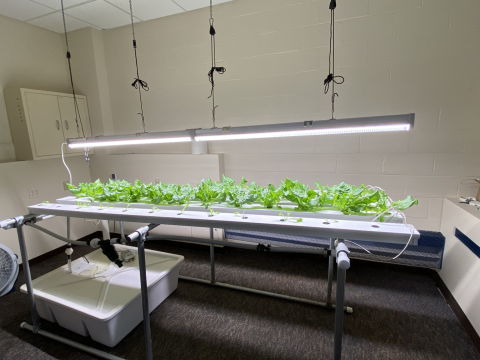
Carbon Dioxide:
This is the naturally occurring molecule in the air out of which plants build themselves and make their food (remember learning about photosynthesis?) The amount of carbon dioxide in earth’s atmosphere currently is about 400 parts per million (that’s just 0.04%... or 400 pounds per 1,000,000 pounds of air!) The carbon dioxide needed for your hydroponics system will come from the air, but it is important that you consider the need for fresh air as your plants take carbon dioxide out of the air. If your system is in a tightly constructed room or sealed chamber, plants performing photosynthesis can lower the carbon dioxide concentration in the air to just 200 parts per million in less than an hour, and at 200 parts per million, photosynthesis functionally stops until fresh air, and more carbon dioxide, is introduced.
Oxygen:
Plants produce oxygen through their leaves during photosynthesis, but they need oxygen too, predominantly at their roots to get energy from the food they have made. When a plant is “overwatered”, it isn’t actually receiving too much water, rather it is being suffocated by being deprived of oxygen at the roots for an extended period of time. A hydroponics system must provide oxygen to the root zone, usually by dissolving air in the water. Depending on the system used, the action/ motion of the nutrient solution may give sufficient oxygenation, but crop health/ yield/ time are definitely improved when the nutrient solution receives additional aeration. For stationary systems like the raft shown below, aeration of the nutrient solution is critical. Aeration can be accomplished using an air pump with an air stone, like those used for aquariums.
Types of systems
Many types of hydroponic systems exist. Some of these systems simply allow roots to be bathed with the nutrient solution whether submerged, in a thin layer or even as a fine mist. Other types of hydroponics use a substance (called a medium) to support the plants and its roots. Recently, several self-contained systems have been introduced for sale to homeowners. These systems are available for sale on the internet and are comprised of the necessary components, including lights, and owners simply need to sow and transplant plants and maintain the nutrient solution.
Here are a few systems that make good small-scale hydroponics:
Potting medium and container:
Most “Potting soils”, like those used for houseplants and annuals and perennials, do not contain soil, and plants grown in them depend on water-soluble fertilizers to provide nutrients. As such, growing plants in pots, or containers, with potting soil and fertilizer is actually a form of hydroponics and can be quite effective for vegetable production. Allow these containers to drain properly as the oxygen required by the roots must be in the pore spaces in the medium. See this UNH Extension publication for more information on growing plants in pots with potting soil .

Nutrient film technique (NFT):
This is a system often used at large scale in commercial production but can be made to fit small spaces. Nutrient solution is held in a reservoir (in the photos below, the reservoir is the orange bucket). It is pumped to the tops of gutters or troughs, where it then runs back to the reservoir from gravity. Plant roots are constantly bathed in a thin layer of nutrient solution.
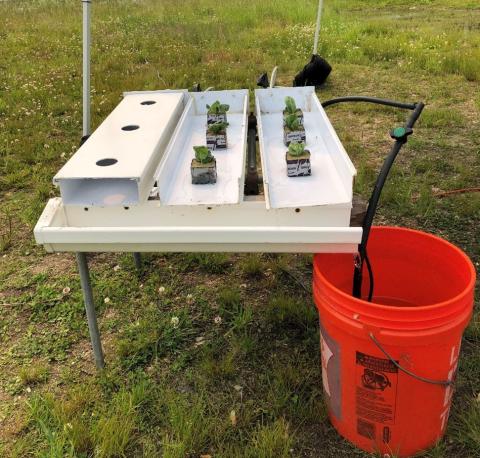

Raft system:
This is another system often used large scale in commercial production but which can be made to fit small spaces. Foam or plastic rafts are floated on ponds of nutrient solution. These rafts have holes through them into which plants are planted. Stems and leaves are on top of the rafts while roots hang freely into the nutrient solution below. Good aeration is extremely important in raft systems to prevent root damage from lack of oxygen in the nutrient solution.
This video describes how to construct a simple raft system that can be built from materials available at a local hardware store or on-line.
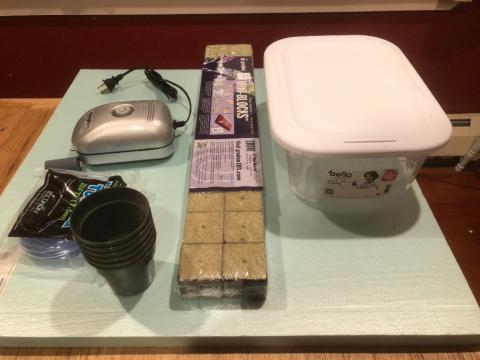
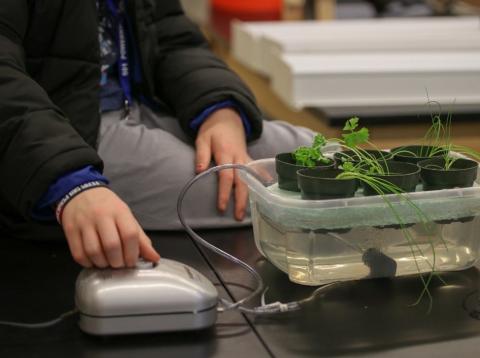
Microgreens tray:
Microgreens are plants grown just until the “true leaf” stage. An advantage of harvesting plants as microgreens is that seeds naturally contain sufficient nutrients to reach this stage, eliminating the need for fertilizers altogether. Another advantage is that because these are meant to be a little stretched with succulent stems, they can often be produced with just the light provided by a sunny windowsill without requiring supplemental lighting.
Since these plants are harvested at such a small stage, many more seeds are needed than in other production systems. Be sure to use seeds not treated with fungicides or insecticides; several seed companies now sell seeds specifically packaged for microgreen production. If available, these microgreen seeds are a better choice than packets containing seeds intended to be grown out into full sized plants.
The microgreens system demonstrated in this video is an extremely affordable, simple system.
Set up a few and sow one per week to keep a constant supply of fresh, tasty greens on a sunny windowsill!
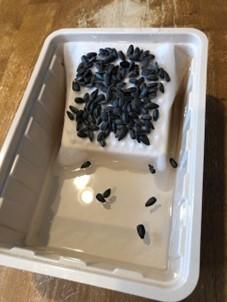

Ready-made home systems:
Recently several types of home hydroponics units are being marketed in stores and online. These range from small table-top “pods” to large free-standing towers. Most include lamps. Many market their own fertilizer to be mixed into the nutrient solution. While these may cost more and be less expandable than a self-built system, they have great ease of use and set-up.
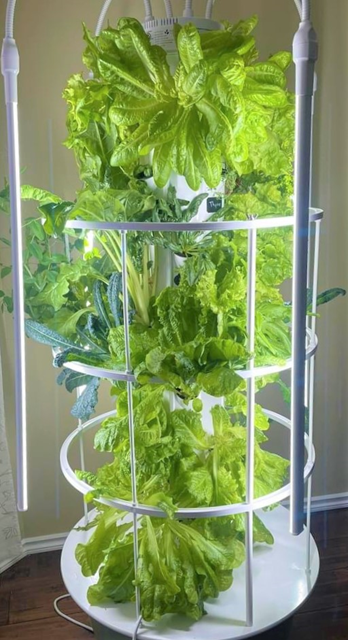
Considerations
Rotations:
Many have experience gardening outdoors where many plants are sown at the same time, grown together and harvested in large quantities at the end of the season. Sometimes hobby hydroponics growers think of their systems the same way. One of the real benefits to year-round production, however, is the ability to plan “rolling harvests” so that small quantities can be harvested consistently throughout the year. Plan on sowing a small amount of your system on a weekly basis so that when the plants start to mature, you can harvest and immediately replant the harvested space.
A nice example: The make-your-own simple raft system shown above has space for 6 heads of lettuce. Grown in a home with reasonable supplemental lighting, lettuce can be a seven-week crop. If you sow one seed per week, after 7 weeks you should be able to harvest one head every week into perpetuity (or until you need to disassemble the system for cleaning).
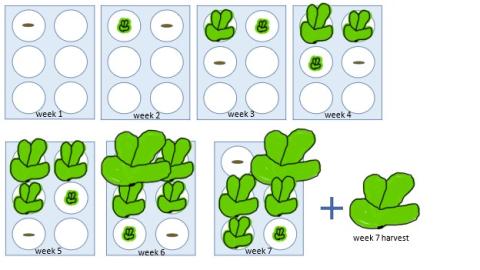
To think of this in the other direction, if you are deciding on how large to make a system and you want to harvest weekly:
Number of heads to harvest weekly x (weeks to grow one head - 1)
= number of sites in the system
In the example above: 1 x (7-1) = 6 sites are required.
Seed starting :
Depending on the system you are using, you may start seeds in a growing block or plug. These are small blocks of material into which seeds are sown and which are transplanted directly into the hydroponics system (often after the plant has grown for a short period). They may be made of rockwool, polymerized peat, foam or other materials. These can be purchased at hydroponics supply stores or online.
Seeds are placed directly into these plugs. After sowing, they need to be kept evenly moist until the seedlings have emerged. A humidity dome may help to keep the germinating seeds moist. After the seedling has grown, the entire growing plug is simply placed into the hydroponics system.
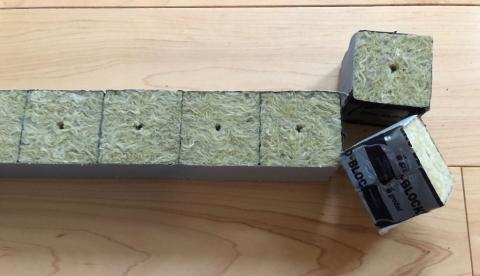
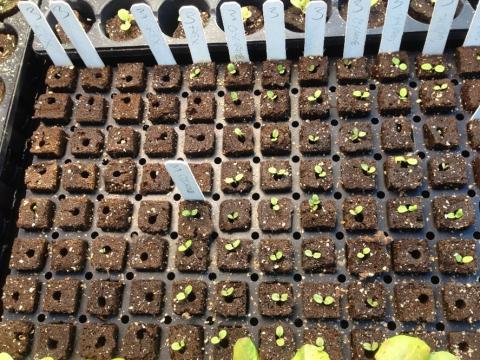
Nursery area:
Often seeds are sown and grown out for one to three weeks in a tray before being placed into the hydroponics system. Not only does this allow for creating optimal conditions for germination versus growing, but it allows seedlings to take up less room than they would in the system. By growing seedlings for a couple weeks at high density before transplanting into the hydroponic system, plants spend fewer weeks in the system, allowing us to get weekly harvests greater than if the plants had grown in the system for their entire life.
Be sure to use a growing plug appropriate for your system, but other than that, growing seedlings in your nursery area is very similar to growing other seedlings for transplant. See this publication for more information on growing seedlings for transplant: https://extension.unh.edu/resource/starting-plants-seed-fact-sheet
Food safety:
Instances of food-borne illness have been very rare in hydroponics, but it is wise to be mindful of food safety in any produce you grow, whether hydroponics or conventional gardening. In hydroponics, since the nutrient solution may persist for periods of time at room temperature, contact between the nutrient solution and the edible parts of the produce should be avoided. Replace the nutrient solution periodically and wash system components between crop cycles. Thoroughly wash your hands before harvesting your crop. Harvest produce dry and wash it just before eating. Wash the harvest tool (knife, scissors, or shear) with hot water and dish soap or in the dish washer between uses so that you don’t contaminate your produce.
Challenges
Algae:
Hydroponics systems don’t typically grow weeds, but they do support algae. Algae thrive in sunlight, moisture and fertilizer: three things in abundance in a functioning hydroponics system. Components should be cleaned between crops when possible. Light should be excluded from the nutrient solution wherever possible. Aeration should be increased to prevent water from sitting stagnant. Chemical treatments to the system to control algae exist but are typically not recommended for household hydroponics.
Pests:
Although hydroponics can have lower pest pressure than other forms of production due to controlled environments and short crop times, some pests can certainly become problematic. Aphids, whitefly, thrips and mites can all reproduce to damaging levels on hydroponic crops. Sometimes, the best solution to an infestation can be to harvest the system, clean it out and start over again. If you decide to use a chemical control, be sure to use a treatment labelled for edible crops and follow all label directions.
Disease:
Some leaf diseases may occur in hydroponics systems, but the greater risk is fungal attack on the roots. Plant diseases like Pythium or Phytophthora can grow in nutrient solution and infect roots. If plants seem stunted or unhealthy, examine the roots. Brown and/ or mushy roots may indicate root rot. Make sure the oxygenation of the nutrient solution is working. Consider sending a sample to your University’s Plant Diagnostic Lab if your state accepts plant samples. If your system is infected with a root rot disease, empty it out, clean and disinfect and start over again.
Calcium deficiency:
Calcium is taken up into a plant when the plant transpires (releases water vapor through its leaves). Indoor conditions can sometimes limit transpiration, resulting in calcium deficiency, even when the amount of calcium in the nutrient solution is sufficient. Calcium deficiency in lettuce appears as dead tissue on the outermost edge of new leaves in the center of the head. Calcium deficiency in tomato results in shiny, rotten areas on the end of the fruit farthest from the stem (blossom-end rot). If the nutrient solution contains sufficient calcium, calcium deficiency can often be overcome by gently increasing airflow with a fan to increase the uptake of water and minerals in the plant. Increase airflow until leaves are lightly “fluttering”.
Nitrogen deficiency:
Nitrogen is the nutrient supplied by fertilizer which is used in the greatest amount by plants. Stunted growth with lower leaves showing uniform yellowing may indicate a nitrogen deficiency. This likely is a result of the nutrient concentration being too dilute. Add fertilizer to obtain the correct concentration and be sure to “top off” the system with nutrient solution (not just water) when it gets low.
A word about organics
An interesting question arises around the topic of “organic hydroponics”. A summary of organic production might be “Feed the soil, not the plant”. By contrast, the driving principle of hydroponics is “Deliver nutrients directly to the plant without using soil”. These two principles are at odds with one another. While it is possible to grow hydroponics with fertilizers approved for organic production, in the absence of soil, this method may be wasteful. Plants do not take up organic molecules; in a complex soil system, microbes in the soil break down organic molecules into ions which can be absorbed by the plant. Conventional fertilizers in a hydroponics system provide those ions directly to the plant in a form it can take up.
Many consumers desire organic produce because of the perception that fewer pesticides are used during production. Hydroponics does frequently require far fewer pesticides than outdoor in-soil production, so although not “organic” due to the fertilizers used, hydroponics can be “pesticide free”.
Both systems can happily co-exist: grow in soil using organic methods in the garden during the growing season and grow hydroponically inside all year round!
A word about aquaponics
Aquaponics are systems in which, instead of dissolving plant nutrients into the nutrient solution, fish (or other aquatic animals) in the system release nitrogen and other molecules as waste products. These waste products are converted into ions used for plant growth by naturally occurring bacteria growing in the system. Construction, maintenance and operation of aquaponics systems are beyond the scope of this fact sheet; contact your Cooperative Extension for more information.
For further study
Watch this presentation given by UNH Extension with UMaine in January 2022 on Hydroponics at Home for a discussion on this topic.
- Inclusion or exclusion of commercial names, logos, products or services does not equate or imply endorsement by UNH Cooperative Extension or the University of New Hampshire. -
Do you love learning about stuff like this?
SUBSCRIBE TO Granite State Gardening newsletter
Got questions? The UNH Extension Yard and Garden Infoline offers practical help finding answers for your yard and garden questions.
Call toll free at 1-877-398-4769, Monday to Friday, 9 a.m. to 2 p.m., or fill out webform.
